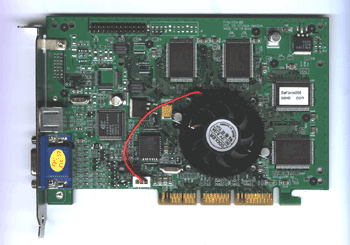
Original Link: https://www.anandtech.com/show/550
Absolute Multimedia Outrageous Ultra GeForce DDR
by Matthew Witheiler on May 20, 2000 12:08 PM EST- Posted in
- GPUs
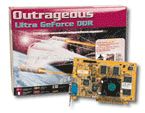 It
has been a bit over 2 months since our last 32 MB DDR GeForce review. Does this
lengthy time frame suggest that the arrival of the GeForce II GTS killed the
DDR GeForce market? Quite the contrary. While we were all eagerly learning more
and more about NVIDIA's latest processor, companies have continued to release
and update products based off the "old" GeForce: the GeForce 256.
Are GeForce 256 based cards budget cards now? No. Are GeForce 256 based cards
useless for a powerful game system? Absolutely not. In fact, with the release
of the GeForce 2 GTS, DDR GeForce cards even have more going for them.
It
has been a bit over 2 months since our last 32 MB DDR GeForce review. Does this
lengthy time frame suggest that the arrival of the GeForce II GTS killed the
DDR GeForce market? Quite the contrary. While we were all eagerly learning more
and more about NVIDIA's latest processor, companies have continued to release
and update products based off the "old" GeForce: the GeForce 256.
Are GeForce 256 based cards budget cards now? No. Are GeForce 256 based cards
useless for a powerful game system? Absolutely not. In fact, with the release
of the GeForce 2 GTS, DDR GeForce cards even have more going for them.
The first event that occurred upon the release of the GeForce 2 GTS that proved to help the GeForce 256 market was the release of NVIDIA's 5.16 driver set. Although these drivers were available before the GeForce 2 GTS's unveiling, the packaging of GeForce 2 GTS cards with the 5.16 drivers all but demolished previous claims of the 5.xx series drivers being unstable and unofficial. We are yet to see NVIDIA post 5.16 drivers for download, but a quick search on the internet reveals a multitude of places to grab these from. By using the 5.16 drivers with 32 MB DDR GeForce cards, the texture swapping that was overwhelming in pervious tests all but disappeared. As described in our 64 MB GeForce review the 5.16 drivers utilize S3TC compression to allow many more textures to fit in the card's built-in 32 MB of RAM. It should now be just a matter of time before these drivers are proclaimed official by NVIDIA and packaged in their detonator driver package.
The second effect of the GeForce 2 GTS's release, and an effect that is yet to reach its full potential, is a price decrease on the GeForce 256 front. Since our DDR GeForce Roundup, we have seen DDR GeForce 256 prices fall anywhere from $20 - $40 depending on the card and retail location. This price drop may not be huge when one is already spending over $240, however it may make the difference between affordable and out of reach. In addition, expect this price to fall even more in upcoming months: as GeForce 2 GTS prices fall and more cards hit the market (which should just be a matter of time), the price of the DDR GeForce 256 cards will continue to fall.
With these facts in mind, as well as the fact that the DDR GeForce 256 is anything but out dated and easily replaced, we bring you our first DDR GeForce 256 review since our DDR GeForce Roundup. This time we bring you Absolute Multimedia's second attempt at the 32 MB DDR GeForce market: the Outrageous Ultra GeForce DDR. In an effort to repair the problems that plagued the original Outrageous GeForce DDR, Absolute Multimedia updated a few features of the original card. Do the updates prove worthy and make this card one of the better lower costing GeForce cards on the market? Let's find out. We begin by looking at the card specs, many of which remain mysteriously unchanged from the original card.
|
Key Features |
|
NVIDIA
GeForce GPU (Graphics Processing Unit)
|
|
32
MB high-speed DDR SGRAM memory
|
|
TV-Output
|
|
New
"Gaming Fan"
|
|
Software
Choice DVD ROM
|
- Graphics Processor
NVIDIA GeForce 256 graphics engine - Bus Interface
1x/2x/4x AGP with fast writes, full sideband/execute mode support - Memory
32 MB high-speed DDR (double data rate) memory - RAMDAC
Built-in 350 MHz - Maximum Resolution
2048 x 1536 pixels - Vertical Frequency
60 Hz to 240 Hz - VGA Connector
DB-15 analog monitor connector, VESA DDC2B, DPMS, VBE 2.0/3.0 - TV-Output
S-Video
Optional DVI connector for digital flat panel
PAL + NTSC support - High-Quality Video
Playback
30 fps full screen DVD playback
DVD and HDTV-ready motion compensation for MPEG-2 decoding
Video acceleration for DirectShow and MPEG1, MPEG-2, and Indeo - 3D Performance
Quad-Engine Design
Hardware Triangle Setup
Hardware Transform and Lighting
32-bit rendering
AGP 4x texture support
Alpha-Blending
Bilinear, Trilinear and 8-tap
Anisotropic filtering
Four rendering pipelines capable of delivering four pixels per clock
Anti-Aliasing
Bump Mapping
Cube Environment Mapping in hardware
Fogging
Render with geometry instead of texture
Subpixel Precision
Transparency
Gouraud Shading
Perspective Correction
32 bit Z + Stencil Buffer - 2D Acceleration
Hardware acceleration for all Windows GDI operations
Multi-buffering (up to quad buffering) for smooth animation and video playback
Fast 32-bit VGA/SVGA support - Software Support
Windows 95/98
Windows NT 4.0
Windows 2000 - Package Contains
Outrageous 3D graphics card
Install / Driver CD-ROM including Video Install and local language manuals
Intervideo DVD DVD software
Software Choice DVD ROM
|
Refresh Rate Support |
||
|
Resolution |
Color |
Max Refresh Rate (Hz) |
|
640 x 480 |
256/65K/16M |
60 - 240 |
|
800 x 600 |
256/65K/16M |
60 - 240 |
|
1024 x 768 |
256/65K |
60 - 240 |
|
1024 x 768 |
16M |
60 - 200 |
|
1152 x 864 |
256/65K |
60 - 200 |
|
1152 x 864 |
16M |
60 - 170 |
|
1280 x 960 |
256/65K |
60 - 170 |
|
1280 x 960 |
16M |
60 - 150 |
|
1280 x 1024 |
256/65K |
60 - 170 |
|
1280 x 1024 |
16M |
60 - 150 |
|
1600 x 900 |
256/65K |
60 - 150 |
|
1600
x 900
|
16M
|
60
- 120
|
|
1600
x 1200
|
256/65K
|
60
- 120
|
|
1600
x 1200
|
16M
|
60
- 100
|
|
1920
x 1080
|
256/65K
|
60
- 100
|
|
1920
x 1080
|
16M
|
60
- 85
|
|
1920
x 1200
|
256/65K
|
60
- 100
|
|
1920
x 1200
|
16M
|
60
- 85
|
|
1920
x 1440
|
256/65K
|
60
- 85
|
|
1920
x 1440
|
16M
|
60
- 75
|
|
2048
x 1536
|
256/65K
|
60
- 75
|
|
2048
x 1536
|
16M
|
60
|
The Card
Besides the green PCB color and the circular fan, the Outrageous Ultra GeForce DDR does not differ very much visually from its Outrageous GeForce DDR brother. The card still uses DDR Infineon SGRAM chips rated at 6 ns, as do all other DDR GeForce cards out there, including GeForce 2 GTS cards. The card continues to utilize NVIDIA's reference design in order to cut costs by decreasing research and development time. Although this is not a bad thing, the vast majority of GeForce cards utilize this design, it does decrease the additional features that a card can have. On the plus side, by using the reference design you can rest assured that no design problems will arise because cards of this type have been extensively tested by NVIDIA as well as card manufacturers.
As mentioned before, the GeForce core itself is cooled via a new "Gaming Fan", as proclaimed by Absolute Multimedia. As is seen in the overclocking section, this heatsink may look different than your standard square heatsink but it performs almost identically. Therefore, one improvement over the original Outrageous GeForce DDR does not seem to be an improvement at all: more of a visual stimulus, proving that looks can be deceiving. Cooling of the card is aided by the use of thermal grease between the GPU surface and heatsink bottom. Usually a feature we expect on more pricey cards, use of thermal grease most definitely allows for the highest level of overclocking to be reached. We will explore how high this is in the overclocking section.
The 32 MB of Infineon 6
ns DDR SGRAM chips are the same as those found on other DDR GeForce cards. In
the past we have discussed how Infineon is currently the only memory company
to be producing DDR SGRAM chips for use in video cards and that the only speed
that they make is 6 ns. These facts remain unchanged in: we have described the
same events in recent GeForce 2 GTS reviews as these memory 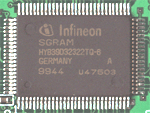 chips
are currently the only ones out there. The one aspect of the memory that has
changed from DDR GeForce cards to DDR GeForce 2 GTS cards is the default speed
of the memory clock. All DDR GeForce 256 based cards, including the Outrageous
Ultra GeForce DDR, come with a stock memory clock speed of 300 MHz (150 MHz
DDR). This number is well below the 333 MHz that the RAM is speced at (6 ns
DDR or 166 MHz DDR). GeForce 2 GTS cards, on the other hand, come with the 333
MHz speed setting as default, suggesting that NVIDIA has put more faith into
the Infineon chips used. This is most likely a result of poor yields on the
initial batches of SGRAM chips: the initial version of the Outrageous GeForce
DDR, for instance, would only provide us with a memory clock speed of 326 MHz
when overclocked, well below the speced range. It seems that Infineon has fixed
this problem and the overclocking section will reveal whether or not the RAM
has improved from the batch received on our last Absolute Multimedia product.
chips
are currently the only ones out there. The one aspect of the memory that has
changed from DDR GeForce cards to DDR GeForce 2 GTS cards is the default speed
of the memory clock. All DDR GeForce 256 based cards, including the Outrageous
Ultra GeForce DDR, come with a stock memory clock speed of 300 MHz (150 MHz
DDR). This number is well below the 333 MHz that the RAM is speced at (6 ns
DDR or 166 MHz DDR). GeForce 2 GTS cards, on the other hand, come with the 333
MHz speed setting as default, suggesting that NVIDIA has put more faith into
the Infineon chips used. This is most likely a result of poor yields on the
initial batches of SGRAM chips: the initial version of the Outrageous GeForce
DDR, for instance, would only provide us with a memory clock speed of 326 MHz
when overclocked, well below the speced range. It seems that Infineon has fixed
this problem and the overclocking section will reveal whether or not the RAM
has improved from the batch received on our last Absolute Multimedia product.
One surprising aspect of the Outrageous Ultra GeForce DDR, one that the Outrageous GeForce DDR also had, is the video-out feature of the card. Powered by the ever-popular Brooktree 869 chip, the Outrageous Ultra GeForce DDR will be able to provide video out with the best of them. This is the same chip as used in almost every NVIDIA card with TV-out since the rise of the TNT2, however we usually associate this feature with more expensive cards. The Absolute Multimedia Outrageous Ultra GeForce DDR breaks this mold.
Last time we reported on the Outrageous GeForce DDR, we asked ourselves how a DDR GeForce can be so low cost compared to the competition. With a bit of investigation, we found that the 2D image quality of the card was extremely poor, especially at high resolutions. We speculated that Absolute Multimedia had cut corners as well as costs when implementing the graphics filters by using lower quality filters which result in a "fuzzy" picture. We are glad to say say that with the arrival of the Outrageous Ultra GeForce DDR, Absolute Multimedia has fixed this major problem. By taking it upon themselves and addressing the image quality issue, Absolute Multimedia was able to correct the problem, whatever it was. If the problem lied in the filters, these filters must have been replaced with higher quality ones. If the problem was elsewhere, that part was replaced. Basically Absolute Multimedia acknowledged the problem and implemented a fix, resulting in a card that is more than capable of displaying clear, crisp 2D graphics and text at resolutions of 1600x1200 and even higher.
Overclocking
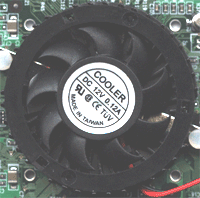 Despite
the use of a self-proclaimed "Gaming Fan", the Absolute Multimedia
Outrageous Ultra GeForce DDR would only provide a core overclock of 36 MHz,
the same amount of speed that we were able to squeeze out of the original Outrageous
GeForce DDR with its run of the mill square heatsink. Although the circular
heatsink may appear drastically different and may offer a tad bit more surface
area compared to standard heatsinks due to its height, in practice these qualities
do not provide a more effective cooling solution. As the old saying goes, looks
can be deceiving. It appears that the circular heatsink's striking look is a
perfect example of this saying in action. Not that a core speed of 156 MHz is
anything to be ashamed of, it is just that it is no better than the maximum
core speed reached by a standard heatsink/fan combination.
Despite
the use of a self-proclaimed "Gaming Fan", the Absolute Multimedia
Outrageous Ultra GeForce DDR would only provide a core overclock of 36 MHz,
the same amount of speed that we were able to squeeze out of the original Outrageous
GeForce DDR with its run of the mill square heatsink. Although the circular
heatsink may appear drastically different and may offer a tad bit more surface
area compared to standard heatsinks due to its height, in practice these qualities
do not provide a more effective cooling solution. As the old saying goes, looks
can be deceiving. It appears that the circular heatsink's striking look is a
perfect example of this saying in action. Not that a core speed of 156 MHz is
anything to be ashamed of, it is just that it is no better than the maximum
core speed reached by a standard heatsink/fan combination.
On the plus side of cooling, the heatsink comes attached to the GPU surface via a thin layer of thermal grease, perfect for aiding heat transfer from the hot GPU surface to the easily cooled heatsink. In the case of the GeForce 256, where the GPU runs rather hot, use of thermal grease can make a large difference compared to cards that do not utilize this method of bonding. Often times thermal grease is avoided due to the fact that it is often hard to put on the GPU in a production line. Using a lesser attachment method, such as thermal glue, saves money by saving labor costs. Absolute Multimedia did not cut corners here, as the thermal grease was properly applied.
Previously we discussed the poor memory overclocking we experienced on the Outrageous GeForce DDR. This is most likely the fault of Infineon and not Absolute Multimedia, as the quality of the SGRAM chips seen on the Outrageous GeForce DDR must have been lower than average. We are happy to say, since it appears that Infineon has solved its production problems, that the memory clock of the new Outrageous Ultra GeForce DDR was much more forgiving. We were able to push the 6 ns SGRAM chips to 350 MHz (175 MHz DDR), 24 MHz higher than we were able to obtain previously. With a core speed of 156 MHz and a memory clock speed of 350 MHz, the Absolute Multimedia Outrageous Ultra GeForce DDR performs at least on par with the other DDR GeForce cards reviewed, surpassing many in some cases.
The Drivers
Once again the Outrageous Ultra GeForce DDR inherits characteristics from its predecessor. In an effort to cut costs and production time, Absolute Multimedia has chosen to package the Outrageous Ultra GeForce with version 3.62 of NVIDIA's reference drivers. As mentioned in previous reviews, the reference drivers prove to suffice in the vast majority of situations. The only items missing by using the NVIDIA reference drivers are a few additional features that we see on only more customized driver sets, such as ELSA's Smart Resolution utility. Absolute Multimedia knows that the majority of power users out there are going to choose the reference drivers anyway due to their frequent updates. Other than these items, not much more can be said regarding the Absolute Multimedia drivers; they are the reference drivers we have grown to love and trust produced by NVIDIA.
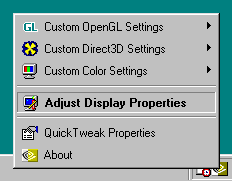
The taskbar settings do not
offer many features, but some are user definable.
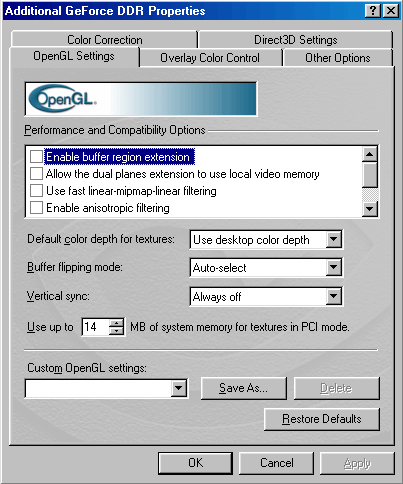
OpenGL settings are easy
to find and change.
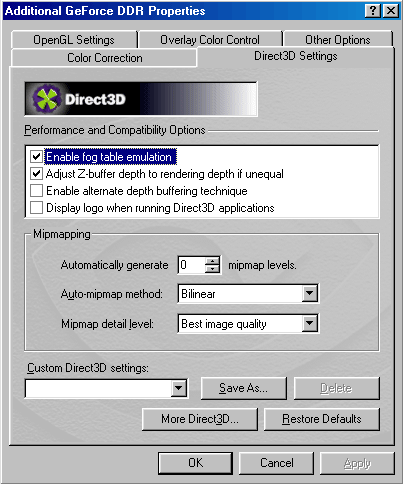
Direct3D settings are also
easy to tweak.
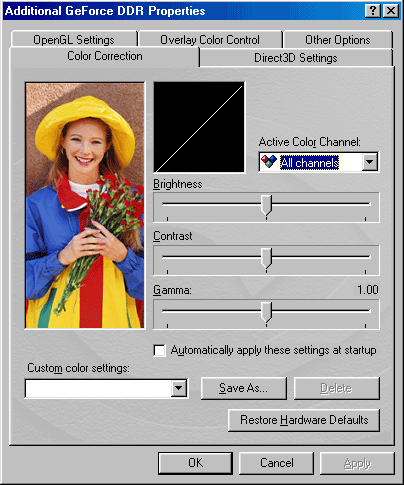
Color adjustment.
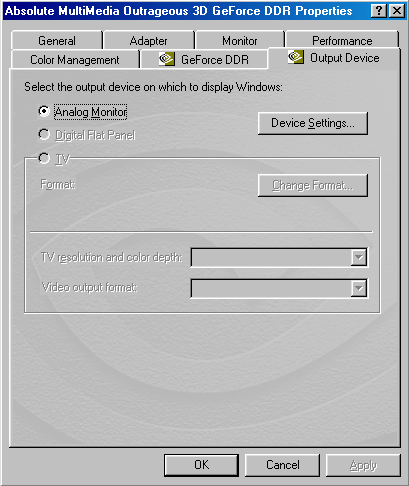
The features of the output
device are easily set via the output device screen.
The Test
|
|
Windows
98 SE Test System
|
|
|
Hardware
|
|
CPU(s) |
Intel
Pentium III 750E |
| Motherboard(s) |
AOPEN
AX6BC PRO
|
| Memory |
128MB PC133 Crucial Technology SDRAM |
| Hard Drive |
Quantum Fireball CR 8.4 GB UDMA 33 |
| CDROM |
Acer 24x |
| Video Card(s) |
Absolute Multimedia Outrageous Ultra GeForce DDR |
|
|
Software
|
|
Operating System |
Windows 98 SE |
| Video Drivers |
|
|
|
Benchmarking Applications
|
| Gaming |
GT
Interactive Unreal Tournament 4.04 UTbench.dem |
Quake III Arena Performance- demo 001
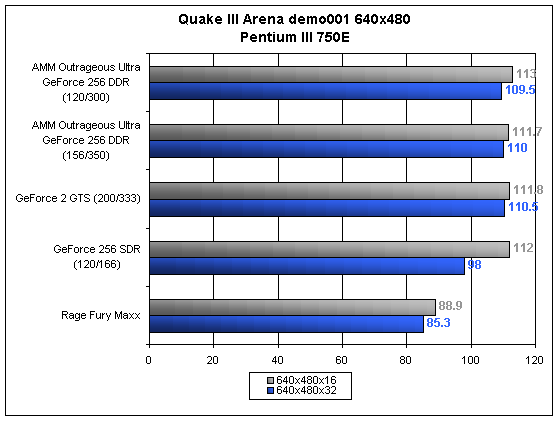
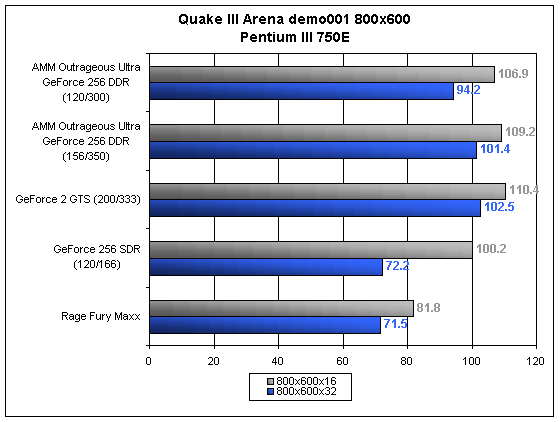
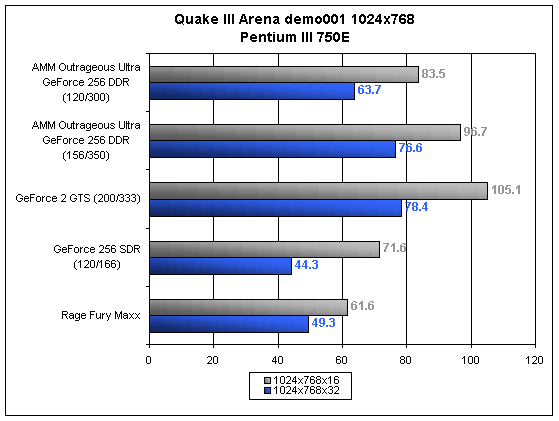
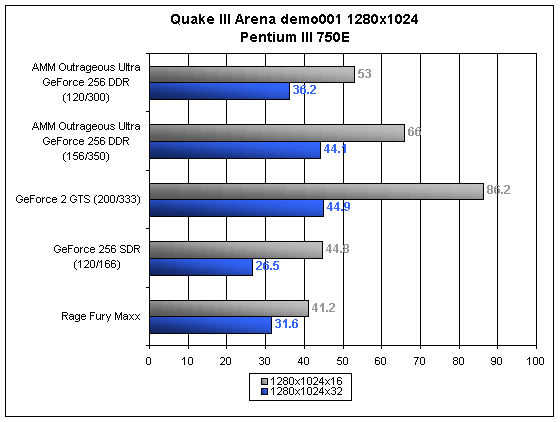
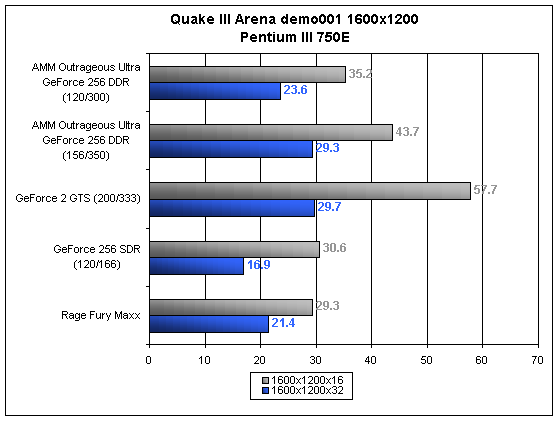
You can see with these benchmarks why it is not safe to completely disregard the DDR GeForce 256 as a powerful gaming solution just because the GeForce 2 GTS came out. True, the card does perform 23% slower when in the common and desirable resolution of 1024x768x32 however this difference drops to a mere 2% when the card is overclocked. With a frame rate of 76.6 FPS when overclocked in 1024x768x32, the Outrageous Ultra GeForce DDR provides more than enough power to sustain even some of the most intensive games.
Quake III Arena Performance- Quaver
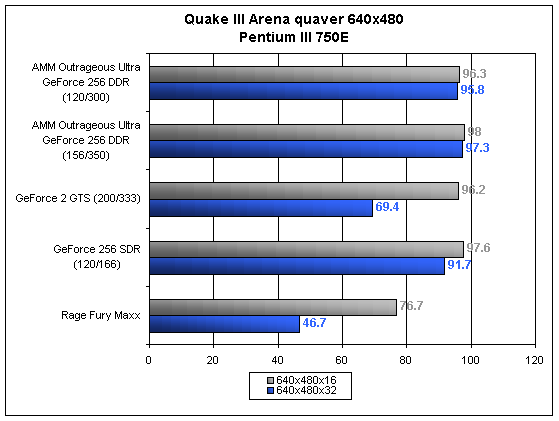
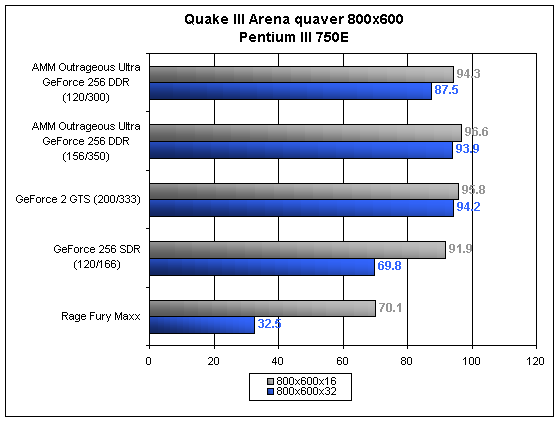
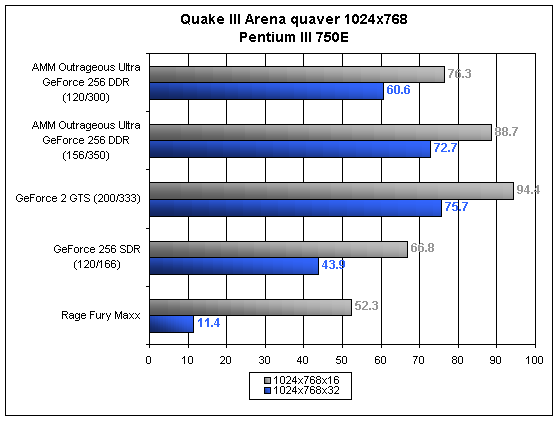
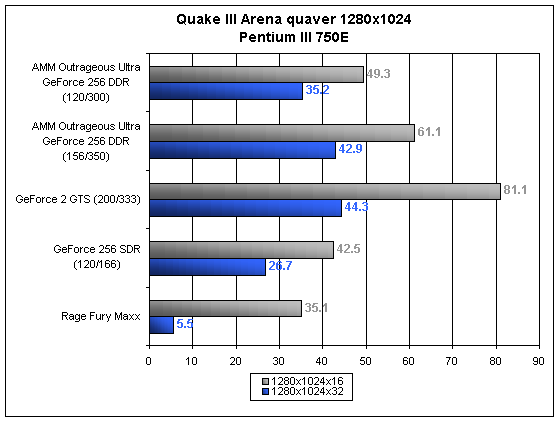
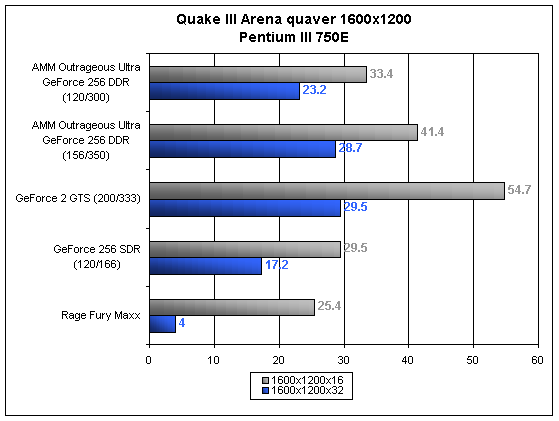
In the Quaver benchmark we see the real benefits of using the 5.16 drivers with a 32 MB GeForce. Due to the S3TC compression use, Quaver no longer dominates and destroys cards with less than 64 MB of RAM. Now the complex textures and scenes that must be stored in the RAM are able to be fit into the local card RAM as opposed to having to travel to the system memory via the slow AGP memory bus. With the Outrageous Ultra GeForce DDR at stock speed, the card performed 25% slower than the GeForce 2 GTS when at the common resolution of 1024x768x32. Once again, this speed margin dropped when the card was overclocked, resulting in a card that was only 4% slower than the GeForce 2 GTS running at stock speed.
At 1280x1024x32, a resolution that the GeForce 2 GTS can usually handle, the Outrageous Ultra GeForce DDR performed 26% slower than the GeForce 2 GTS. When overclocked the card proved to perform within 1.4 FPS of the GeForce 2 GTS, a margin of only 3% slower.
Unreal Tournament Performance
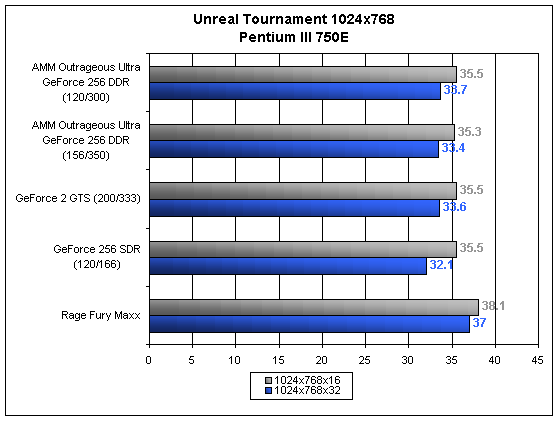
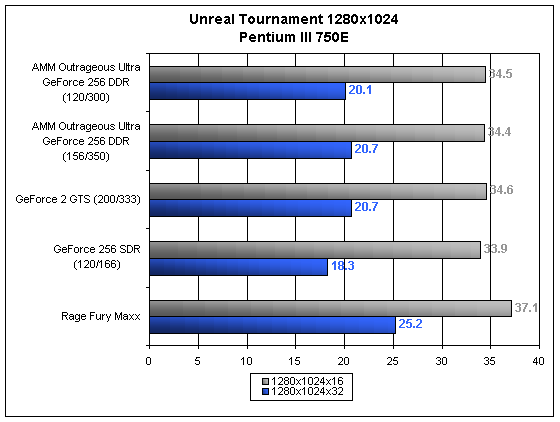
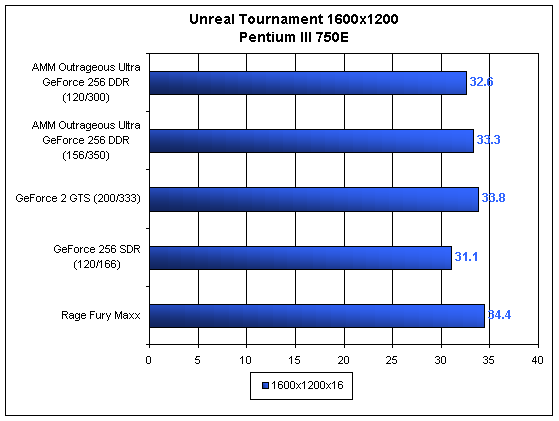
In our Unreal Tournament tests we see the same results we have seen for some time now: nearly identical scores. It seems that the Unreal engine could care less what your core and memory speeds are: it is more interested in the CPU speed. The only noticeable difference comes with a comparison between the SDR GeForce and any DDR GeForce at 1280x1024x32. At this resolution the slow memory bus of the SDR GeForce limits its ability to keep up with the rest of the pack.
Conclusion
There are often many motives to introducing a updated card model. In some cases a company will add features to a dying product line in order to revive sales. Other times a company will maintain the same name simply due to brand name recognition even though a product may have changed drastically. Neither of these cases appear to be the motive behind Absolute Multimedia's Outrageous Ultra GeForce DDR card update. Absolute Multimedia may try to mask this update as a new card targeted at hard core gamers but the true purpose of this revamp is on a more basic level: Absolute Multimedia knew of the 2D image problems encountered in the Outrageous GeForce DDR and needed to fix them.
Masked or not, the update is well needed and long awaited. By repairing the 2D image quality problems that plagued the first version, Absolute Multimedia has created a lower cost DDR GeForce card that is on the same field as more expensive ones. Although the "gaming fan" provides no noticeable improvement over a standard heatsink and fan combination, the card does contain some features we usually only expect on higher cost cards. The video-out powered by the Brooktree 869 chip as well as the use of thermal grease in bonding the GPU to the heatsink surface are usually features that we find and request on higher priced cards. The Absolute Multimedia Outrageous Ultra GeForce DDR gets some good points by including these features.
Absolute Multimedia, the company which first brought Software Select to the video card market, continues this tradition in with the Outrageous Ultra GeForce DDR. The card comes with a certificate that entitles the user to 3 of some of the more popular game titles that we have seen. You may choose from games such as Unreal Tournament, Heretic II and Darkan as well as many other quality games. This feature is a definite plus, as the software bundle is not only customizable for each user but also includes games that we may actually enjoy playing, unlike the games included in other software packages. The package also comes with WinDVD for software DVD recording: a useful feature to couple with the Brooktree 869 video out chip. Also pleasing is the card's extensive warranty: 3 years of covered care. It is always reassuring to see a company that has faith behind their products and is willing to place a comprehensive warranty to back their confidence.
The Outrageous Ultra GeForce DDR brings what the Outrageous GeForce DDR should have originally delivered. By providing clear, crisp text and graphics at resolutions of 1600x1200 and higher, our initial reservations regarding the Outrageous GeForce DDR are all thrown out. By updating the card to produce the Outrageous Ultra GeForce DDR, Absolute Multimedia now has a card that is able to compete with others in this class. We are unsure whether the Outrageous Ultra GeForce DDR will be replacing the Outrageous GeForce DDR completely or if it will be sold along side the original card. It appears that the Ultra will replace the first version, but just in case, if you are looking for a lower costing DDR GeForce card stay away from the Outrageous GeForce DDR and go with the new Outrageous Ultra GeForce DDR.
How It Rates
Please note that the score given is a comparison between the Absolute Multimedia Outrageous Ultra GeForce DDR and other DDR GeForce cards on the market. This is not meant to reflect how the GeForce 256 GPU compares to other GPUs on the market.
|
AnandTech Video Card Rating |
|
|
Rating
(x/10)
|
|
|
Performance
|
5.0
|
|
Price
|
6.5
|
|
Drivers
|
5.0
|
|
Features
|
6.0
|
|
Retail Availability
|
6.0
|
|
Documentation & Software Bundle
|
5.5
|
| Overall Rating |
5.5
|
Note: The Overall Rating is not an average of all of the categories. Click here to see why.

